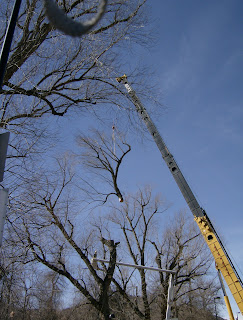Campus users may have noticed the recent removals of several large trees on the main campus and along the creek path north of campus. We took down several Willows and Silver Maples this fall and winter and there will likely be more removals scheduled before summer. Our campus has a large number of these two particular species of trees, many of which have matured to ages of around one hundred years. These are fast growing, very large shade trees which have enhanced the campus' landscape for decades
Unfortunately, these are trees which tend to age rather poorly as they are soft wooded and prone to storm damage. They also are ineffective at resisting decay making them attractive to many forms of animal colonization from bacteria on up to raccoons. Consequently, they often become potentially hazardous in their late years as large branches and trunks become hollowed out by weather erosion and animal nesting. We take all removals of trees on our campus seriously and we make every effort to retain trees as long as is safely possible. We must also practice all precautions aiming to keep our campus users, and their property, safe. The trees we have removed this fall, winter, and spring were moving into an unreasonable threshold for risk on a busy campus and we had to make the decision to remove them.
Our Outdoor Services Department, as well as the department of Planning, Design and Construction, make every effort to plant many trees every spring and fall. This takes place in the form of replacement trees for removals, new trees at new building sites, and Memorial trees donated by campus and community members. We have planted upwards of 100 trees in just the last few growing seasons and we hope to keep up a healthy replacement program for our campus' urban forest for years to come.
The following pictures illustrate some of the deficits in holding material present in some of the trees removed.
The exposed base of this willow shows how little living tissue was left in the lower trunk. The saw is about 8 inches long, the trunks' base was several feet across.
These large stems had significant decay and open cracks were starting to form, creating an unsafe tree.
-Vince Aquino



